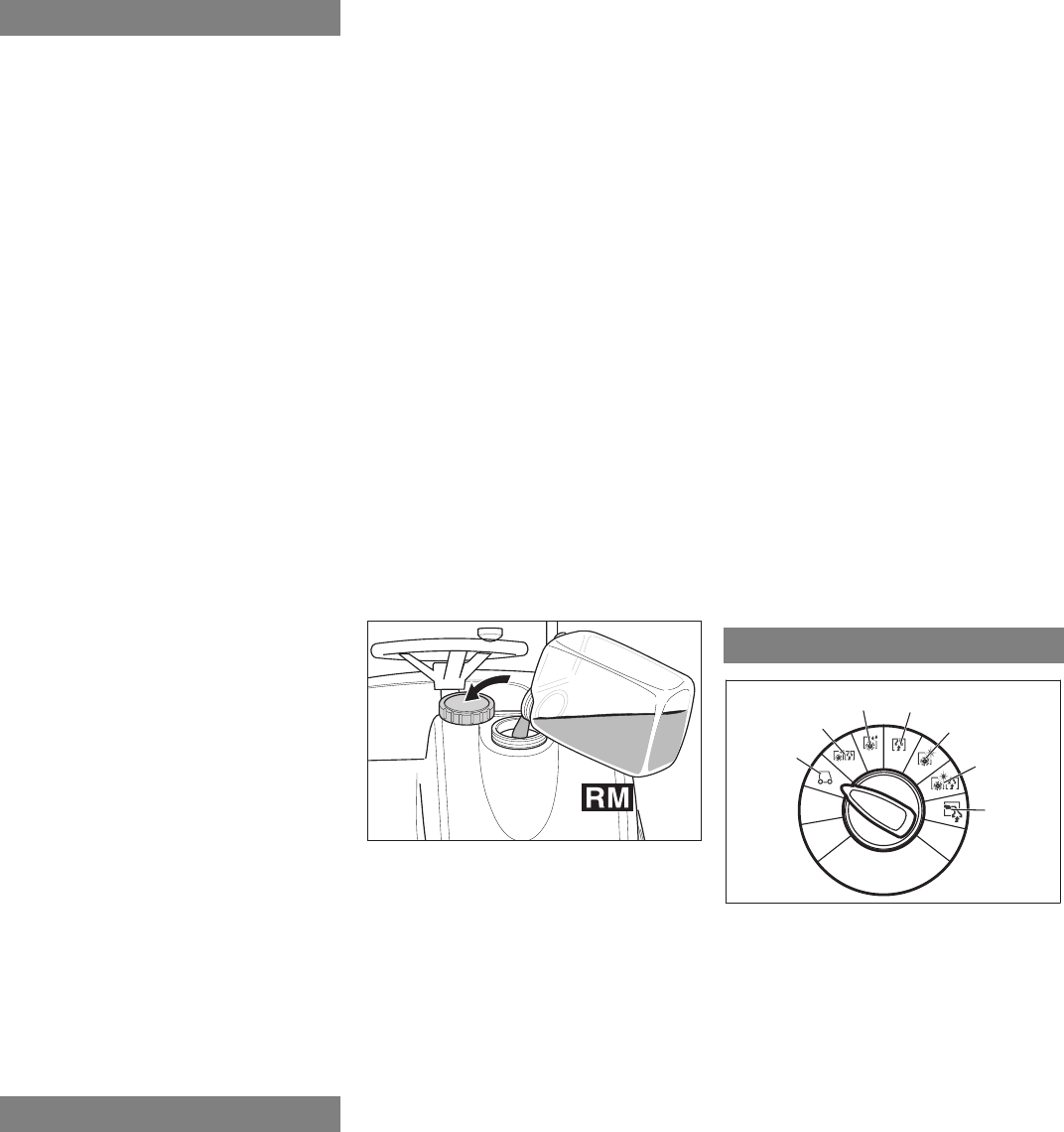
10 English
ƽ Danger
Danger of tipping if gradient is too high.
Î The gradient in the direction of travel
should not exceed 10%.
Danger of tipping when driving round bends
at high speed.
Danger of slipping on wet floors.
Î Drive slowly when cornering.
Danger of tipping on unstable ground.
Î Only use the machine on sound surfac-
es.
Danger of tipping with excessive sideways
tilt.
Î The gradient perpendicular to the direc-
tion of travel should not exceed 10%.
Note
The machine is designed in such a way that
the brush head protrudes on the right. This
helps in working in a proper way even close
to the edges.
Î Sit on the seat and set main switch to
“1”.
Î Set the drive direction using the drive di-
rection button at the operator console.
Î Determine the driving speed by press-
ing the drive pedal.
Î Stop the machine: Release the drive
pedal.
Note
The drive direction can also be changed
during the drive. You can thus clean very
dirty surfaces by driving back and forth a
couple of times.
In case of overloading, the drive motor au-
tomatically switches off after a certain peri-
od. A fault message is displayed on the
console.
The concerned unit gets switched off if the
controls get overheated.
Î Allow machine to cool down at least for
15 minutes.
Î Set main switch to “0”.
Î Wait for a while.
Î Set main switch to “1”.
ṇ Warning
Risk of damage. Only use the recommend-
ed detergents. With respect to different de-
tergents the operator bears the increased
risk regarding the operational safety and
danger of accident.
Only use detergents that are free from sol-
vents, hydrochloric acid and hydrofluoric
acid.
Note
Do not use highly foaming detergents.
Î Open the cover of the fresh water reser-
voir.
Î Fill fresh water (max. 60 °C (140°F)) un-
til 15 cm (6 in) below the upper edge of
the tank.
Î Pour in detergent.
Î Close the cover of the fresh water reser-
voir.
Note
Fill up the fresh water tank completely be-
fore starting up the machine to ventilate the
water supply system.
While cleaning floors in hygiene-related ar-
eas (such as hospitals, supermarkets) and
for thoroughly cleaning very dirty floors.
Î Open the cover of the fresh water reser-
voir.
Î Fill up fresh water (maximum 60 °C
(140 °F)) until the lower edge of filling
nozzle.
Î Add detergent. Follow dosing instruc-
tions for detergent.
Î Close the cover of the fresh water reser-
voir.
Detergent is added to the fresh water on the
way to the cleaning head with the help of a
dosaging device.
ṇ Warning
Risk of damage to the dosing equipment.
Do not add detergent to the fresh water res-
ervoir.
Note
The dosing equipment can be used to add
3% of detergent at maximum.
Î Place the detergent bottle in the holder
in the front on the fresh water reservoir.
Î Close the bottle lid.
Î Insert the suction hose of the dosing
equipment into the bottle. Ensure that
the sieve of the suction hose is lying at
the base of the bottle.
Î Close the bottle using the lid of the dos-
ing equipment.
You can check the filling level of the bottle
through a vertical view window.
If the filling level of the detergent reaches
the bottom of the bottle:
Î Add detergent or replace detergent bot-
tle.
ṇ Warning
If you want to change the detergent type,
then first rinse the suction hose thoroughly
using fresh water (for 60 seconds using
maximum quantity of water and 3% dosing)
in order to avoid chemical reactions.
Note
When the detergent bottle is fully emptied,
then operate the dosing equipment for 60
seconds with maximum quantity of water
and 3% dosing so that the suction hose is
again fully filled up with the detergent.
Note
While refilling or replacing the detergent
bottle, hang in the suction hose of the dos-
ing equipment into the opened fresh water
tank so that no detergent drops fall on the
floor.
Note
If the fresh water tank is empty, then the
function of adding detergent gets deactivat-
ed. The cleaning head continues to work
without the addition of any liquid.
Note
As soon as the detergent pump starts run-
ning, this is indicated through a blinking "C"
in the display.
1Driving
Driving to the Place of Use.
2 Scrubbing suction
Wet clean the floor and vacuum up dirty
water.
3 Wet scrubbing
Wet clean the floor and allow the deter-
gent to react.
4 Vacuuming
Suck in the dirty fleet.
5 Polishing
Polishing the floor without the applica-
tion of liquid.
6 Scrub the floor without applying water
(vacuum polishing)
Polish the floor without applying any flu-
id and suck in the polishing dust.
7 Manual cleaning
Apply liquid detergent using the wall-
ceiling-floor nozzle (optional) and vacu-
um it again.
Driving
Overload
Filling in detergents
Detergent
Fresh water
Working without automatic detergent
dosing
Dosing equipment for detergent
Cleaning Programs
1
2
3
4
5
6
7


















